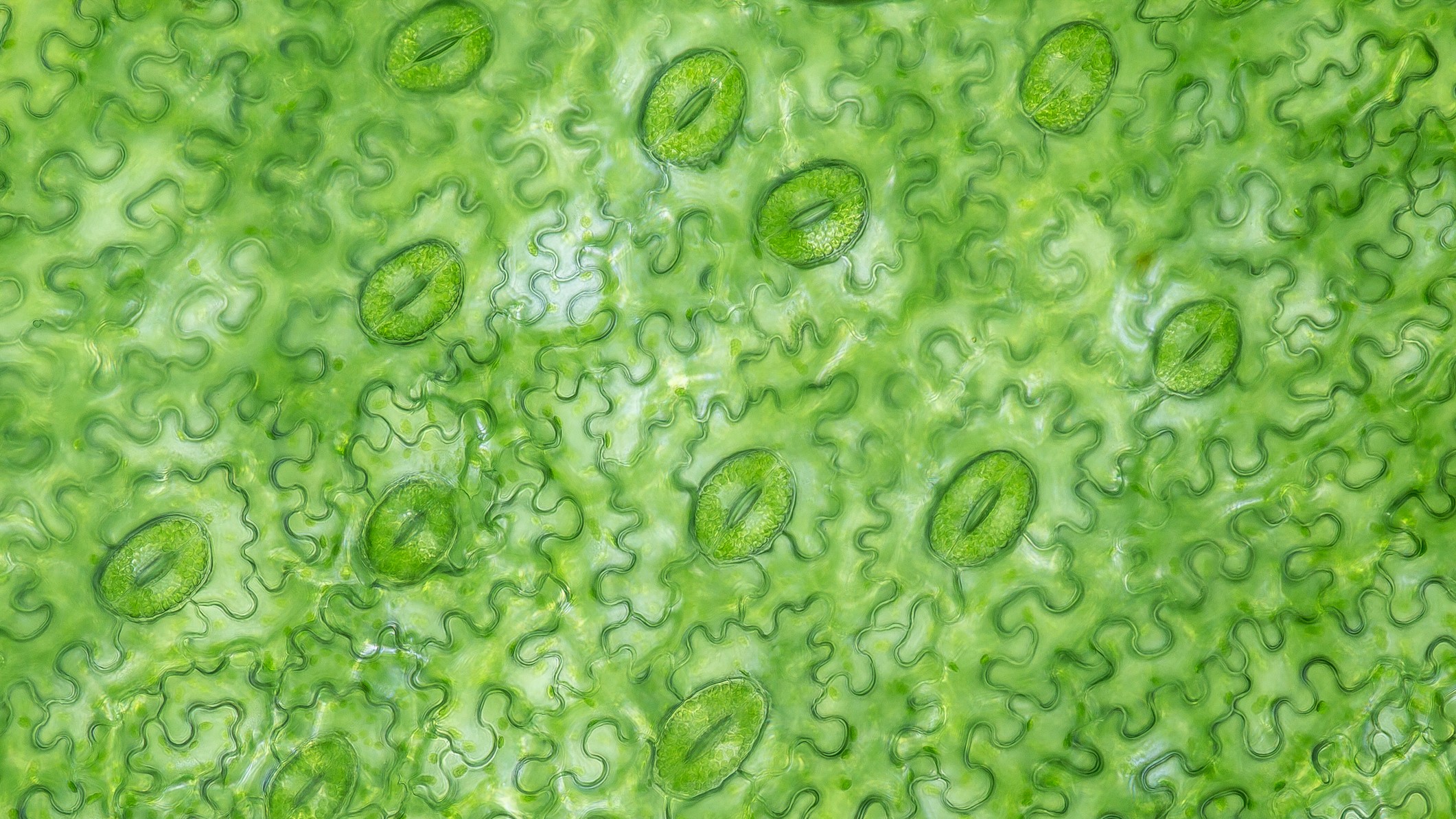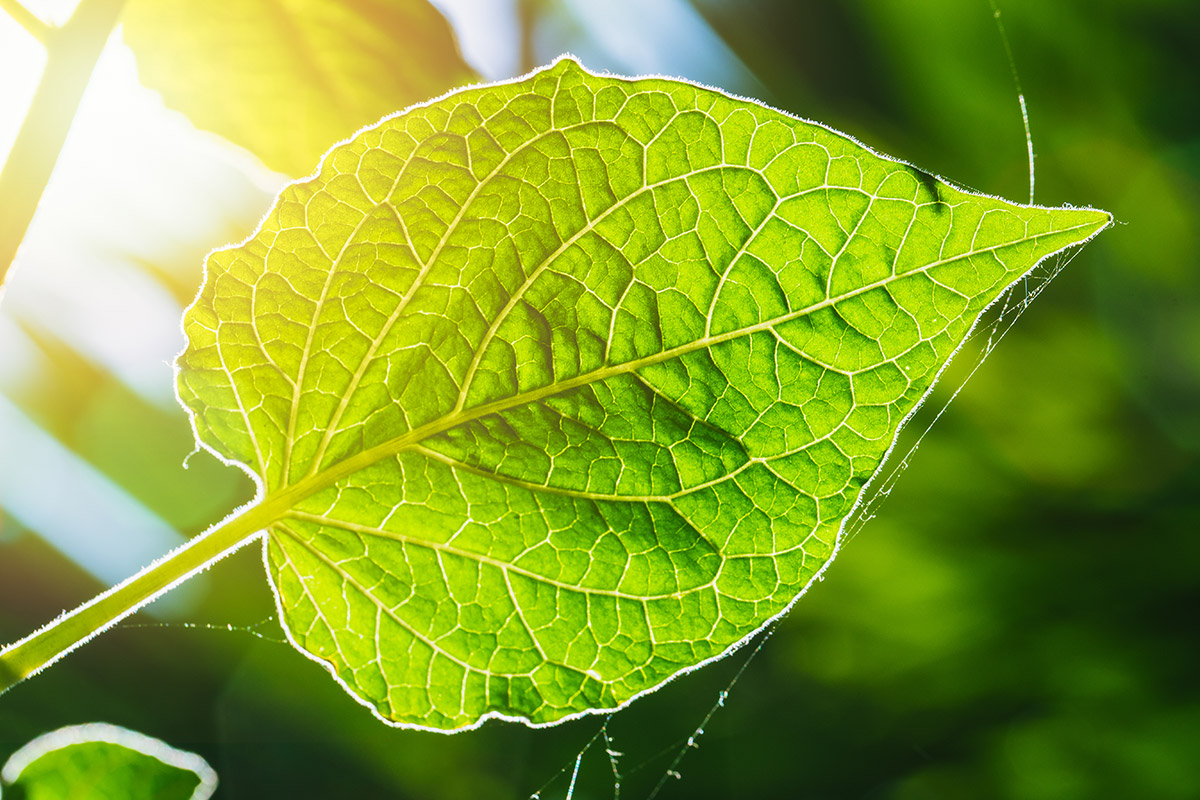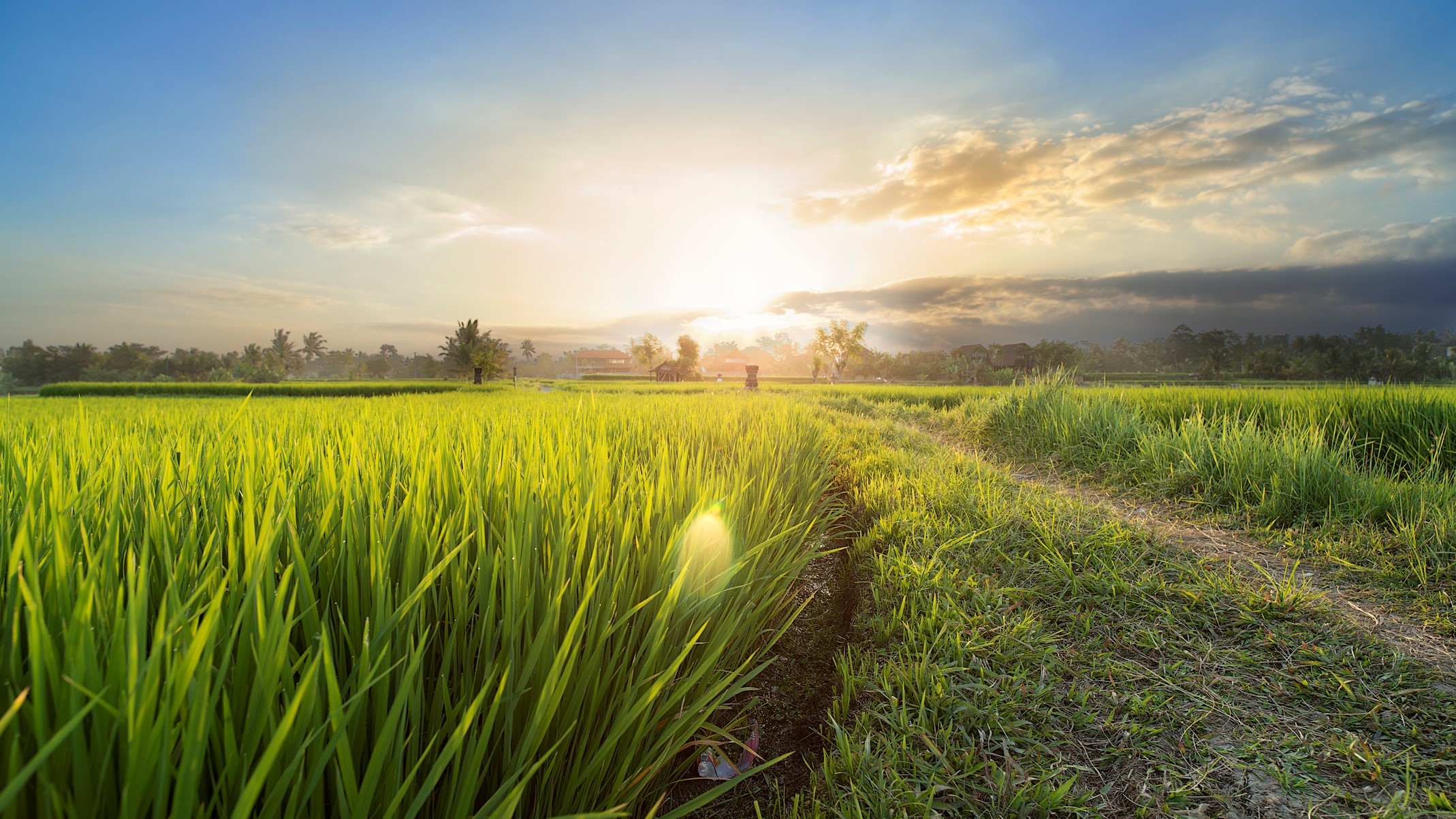what do the c,h and o come from that are used to make sure in photosynthesis
What is photosynthesis?

Photosynthesis is the process used past plants, algae and certain bacteria to turn sunlight, carbon dioxide (CO2) and water into food (sugars) and oxygen. Hither'south a expect at the general principles of photosynthesis and related research to assist develop clean fuels and sources of renewable energy.
Types of photosynthetic processes
In that location are two types of photosynthetic processes: oxygenic photosynthesis and anoxygenic photosynthesis. They both follow very similar principles, just oxygenic photosynthesis is the most common and is seen in plants, algae and cyanobacteria.
During oxygenic photosynthesis, low-cal energy transfers electrons from water (H2O) taken upwards by found roots to CO2 to produce carbohydrates. In this transfer, the CO2 is "reduced," or receives electrons, and the water is "oxidized," or loses electrons. Oxygen is produced along with carbohydrates.
Oxygenic photosynthesis functions as a counterbalance to respiration past taking in the CO2 produced by all animate organisms and reintroducing oxygen to the temper.
Anoxygenic photosynthesis, meanwhile, uses electron donors that are non water and practice not produce oxygen, co-ordinate to "Anoxygenic Photosynthetic Bacteria" by LibreTexts. The process typically occurs in bacteria such equally greenish sulfur bacteria and phototrophic purple bacteria.
The Photosynthesis equation
Though both types of photosynthesis are complex, multistep affairs, the overall process tin can be neatly summarized equally a chemical equation.
The oxygenic photosynthesis equation is:
6CO2 + 12H2O + Lite Energy → C6H12O6 + 6O2 + 6H2O
Here, 6 molecules of carbon dioxide (CO2) combine with 12 molecules of h2o (Water) using low-cal energy. The terminate consequence is the formation of a single saccharide molecule (C6H12O6, or glucose) along with half dozen molecules each of oxygen and water.
Similarly, the diverse anoxygenic photosynthesis reactions tin can be represented equally a single generalized formula:
CO2 + 2H2A + Light Energy → [CH2O] + 2A + Water
The alphabetic character A in the equation is a variable, and H2A represents the potential electron donor. For example, "A" may stand for sulfur in the electron donor hydrogen sulfide (H2S), according to medical and life sciences news site News Medical Life Sciences.
How is carbon dioxide and oxygen exchanged?

Plants absorb CO2 from the surrounding air and release water and oxygen via microscopic pores on their leaves called stomata. Stomata are the gatekeepers of gas exchange between the inside of plants and the external environment.
When stomata open up, they let in CO2; yet, while open, the stomata release oxygen and allow water vapor escape. In a bid to reduce the corporeality of h2o lost, stomata close, just that means the found can no longer gain CO2 for photosynthesis. This tradeoff between CO2 gain and water loss is a particular problem for plants growing in hot, dry out environments.
How practice plants absorb sunlight for photosynthesis?
Plants contain special pigments that absorb the light energy needed for photosynthesis.
Chlorophyll is the primary paint used for photosynthesis and gives plants their green color, according to science education site Nature Pedagogy. Chlorophyll absorbs carmine and blue light to use in photosynthesis and reflects light-green lite. Chlorophyll is a large molecule and takes a lot of resource to make; every bit such, it breaks down towards the end of the leafage's life, and near of the pigment'southward nitrogen (one of the edifice blocks of chlorophyll) is resorbed back into the plant, according to Harvard University's The Harvard Forest. When leaves lose their chlorophyll in the fall, other leaf pigments such as carotenoids and anthocyanins begin to show their true colors. While carotenoids primarily absorb blue low-cal and reflect yellow, anthocyanins absorb blue-green light and reflect red light.
Pigment molecules are associated with proteins, which allow them the flexibility to move toward light and toward one another. A large collection of 100 to 5,000 pigment molecules constitutes an "antenna," co-ordinate to an commodity by Wim Vermaas, a professor at Arizona State University. These structures effectively capture light energy from the sunday, in the form of photons.
The situation is a little different for bacteria. While cyanobacteria comprise chlorophyll, other bacteria, for example, majestic bacteria and green sulfur leaner, incorporate bacteriochlorophyll to absorb light for anoxygenic photosynthesis, co-ordinate to "Microbiology for Dummies" (For Dummies, 2019).
Related: What if humans had photosynthetic skin?
Where in the plant does photosynthesis take place?

Photosynthesis occurs in chloroplasts, a type of plastid (an organelle with a membrane) that contains chlorophyll and is primarily found in constitute leaves. Double-membraned plastids in plants and algae are known as main plastids, while the multiple-membraned multifariousness constitute in plankton are called secondary plastids, according to a 2010 article in the journal Nature Teaching by Cheong Xin Chan and Debashish Bhattacharya, researchers at Rutgers University in New Jersey.
Chloroplasts are similar to mitochondria, the energy centers of cells, in that they have their own genome, or collection of genes, contained within circular Deoxyribonucleic acid. These genes encode proteins that are essential to the organelle and to photosynthesis.
Inside chloroplasts are plate-shaped structures called thylakoids that are responsible for harvesting photons of calorie-free for photosynthesis, according to the biology terminology website Biology Online. The thylakoids are stacked on height of each other in columns known every bit grana. In between the grana is the stroma — a fluid containing enzymes, molecules and ions, where sugar formation takes identify.
Ultimately, light energy must exist transferred to a pigment-protein complex that can catechumen it to chemical free energy, in the grade of electrons. In plants, light energy is transferred to chlorophyll pigments. The conversion to chemical energy is accomplished when a chlorophyll pigment expels an electron, which can then motility on to an appropriate recipient.
The pigments and proteins that convert low-cal energy to chemical energy and begin the process of electron transfer are known as reaction centers.
The reactions of plant photosynthesis are divided into two major stages: those that crave the presence of sunlight (light-dependent reactions) and those that do non (low-cal-independent reactions). Both types of reactions take place in chloroplasts: light-dependent reactions in the thylakoid and calorie-free-independent reactions in the stroma.
Light-dependent reactions
When a plant absorbs solar energy it outset needs to catechumen it into chemic energy.
When a photon of low-cal hits the reaction heart, a pigment molecule such as chlorophyll releases an electron.
The released electron manages to escape by traveling through an electron transport chain, which generates the energy needed to produce ATP (adenosine triphosphate, a source of chemical free energy for cells) and NADPH — both of which are required in the next stage of photosynthesis in the Calvin bike. The "electron hole" in the original chlorophyll paint is filled by taking an electron from water. This splitting of water molecules releases oxygen into the atmosphere.
Light-independent reactions: The Calvin cycle

The Calvin wheel uses energy stored from the light-dependent reactions to fix CO2 into sugars needed for found growth. According to the Khan Academy, these reactions take place in the stroma of the chloroplasts and are not straight driven past calorie-free — hence their name "light-contained reactions." Nevertheless, they are yet related to light as the Calvin cycle is fuelled past ATP and NADPH (both from the previously mentioned light-dependent reactions).
Firstly, CO2 combines with ribulose-1,5-bisphosphate (RuBP) which is a five-carbon acceptor, according to the Khan Academy. Adjacent, it splits into two molecules of a 3-carbon compound — iii-phosphoglyceric acrid (iii-PGA). The reaction is catalyzed by an enzyme called RuBP carboxylase/oxygenase, also known as rubisco.
The second phase of the Calvin bicycle involves converting iii-PGA into a three-carbon carbohydrate called glyceraldehyde-3-phosphate (G3P) — the process uses ATP and NADPH. Finally, while some G3P molecules are used to make glucose, others are recycled back to make RuBP, which is used in the get-go step to accept CO2. For every one molecule of G3P that makes glucose, five molecules are recycled to generate three RuBP acceptor molecules.
Photorespiration
According to the Khan Academy, rubisco can sometimes ready oxygen instead of CO2 in the Calvin cycle, which wastes free energy — a procedure known every bit photorespiration. The enzyme evolved during a time when atmospheric CO2 levels were loftier and oxygen was rare, so it had no reason to differentiate betwixt the two, according to researchers in Canada.
Photorespiration is a particularly large trouble when plants have their stomata closed to conserve water and are therefore not taking in any more CO2. Rubisco has no other choice but to set up oxygen instead, which in turn lowers the photosynthetic efficiency of the plant. This means that less plant food (sugars) will exist produced, which could result in a slowdown of growth and therefore smaller plants.
This is a big problem for agriculture, as smaller plants mean a smaller harvest. There are mounting pressures on the agricultural industry to increment found productivity to feed our ever-expanding global population. Scientists are constantly looking for means to increase photosynthetic efficiency and reduce the occurrence of wasteful photorespiration.
Types of photosynthesis
There are three main types of photosynthetic pathways: C3, C4 and CAM. They all produce sugars from CO2 using the Calvin cycle, only each pathway is slightly unlike.

C3 photosynthesis
Most plants use C3 photosynthesis, according to the photosynthesis research project Realizing Increased Photosynthetic Efficiency (RIPE), including cereals (wheat and rice), cotton, potatoes and soybeans. C3 photosynthesis is named for the three-carbon compound called 3-phosphoglyceric acid (three-PGA) that it uses during the Calvin bicycle. 3-PGA is produced when rubisco fixes CO2, forming the three-carbon chemical compound.
C4 photosynthesis
Plants such every bit maize and sugarcane use C4 photosynthesis. This procedure uses a four-carbon compound intermediate (called oxaloacetate) which is converted to malate, according to Biology Online. Malate is and so transported into the packet sheath where it breaks down and released CO2, which is then fixed by rubisco and made into sugars in the Calvin cycle (just like C3 photosynthesis). C4 plants are better adapted to hot, dry environments and tin continue to fix carbon even when their stomata are airtight (as they have a clever storage solution), which reduces their gamble of photorespiration, co-ordinate to Biology Online.
CAM photosynthesis
Crassulacean acid metabolism (CAM) is found in plants adapted to very hot and dry environments, such equally cacti and pineapples, according to the educational website Khan Academy. When stomata open to take in CO2, they risk losing water to the external environment. Because of this, plants in very arid and hot environments have adjusted. One adaptation is CAM, whereby plants open stomata at night (when temperatures are lower and water loss is less of a adventure). According to the Khan Academy, CO2 enters the plants via the stomata and is fixed into oxaloacetate and converted into malate or another organic acid (like in the C4 pathway). The CO2 is and then bachelor for light-dependent reactions in the daytime, and stomata close, reducing the risk of water loss.
How photosynthesis could gainsay climate change
Photosynthetic organisms are a possible means to generate clean-burning fuels such as hydrogen. A enquiry grouping at the University of Turku in Finland tapped into the ability of greenish algae to produce hydrogen. Green algae can produce hydrogen for a few seconds if they are first exposed to dark, anaerobic (oxygen-complimentary) conditions and then exposed to calorie-free. The researchers devised a way to extend green algae's hydrogen product for upwardly to three days, as reported in their 2018 study published in the journal Energy & Environmental Science.
Scientists have too made advances in the field of artificial photosynthesis. For case, a group of researchers from the University of California, Berkeley, developed an bogus organization to capture CO2 using nanowires, or wires that are a few billionths of a meter in diameter. The wires feed into a system of microbes that reduce CO2 into fuels or polymers past using energy from sunlight. The team published its design in 2015 in the journal Nano Letters.
In 2016, members of this same group published a study in the journal Science that described some other artificial photosynthetic organization in which specially engineered leaner were used to create liquid fuels using sunlight, water and CO2. In general, plants are only able to harness about one percent of solar free energy and use it to produce organic compounds during photosynthesis. In contrast, the researchers' artificial system was able to harness ten% of solar free energy to produce organic compounds.
In 2019, researchers wrote in the Journal of Biological Chemistry that cyanobacteria could boost the efficiency of the enzyme rubisco. Scientists found that this bacteria is particularly good at concentrating CO2 in its cells, which helps cease rubisco from accidentally binding to oxygen. By understanding how the leaner achieve this, scientists hope to incorporate the mechanism into plants to aid boost photosynthetic efficiency and reduce the risk of photorespiration.
Continued research of natural processes aids scientists in developing new ways to utilise various sources of renewable free energy, and tapping into the power of photosynthesis is a logical pace for creating clean-called-for and carbon-neutral fuels.
Boosted resources
- Observe more facts most photosynthesis with the educational scientific discipline website sciencing.com.
- Explore how foliage construction affects photosynthesis with The University of Arizona.
- Learn most the dissimilar means photosynthesis tin can exist measured with the educational scientific discipline website Science & Plants for Schools.
conollyovelinterst.blogspot.com
Source: https://www.livescience.com/51720-photosynthesis.html

0 Response to "what do the c,h and o come from that are used to make sure in photosynthesis"
Post a Comment